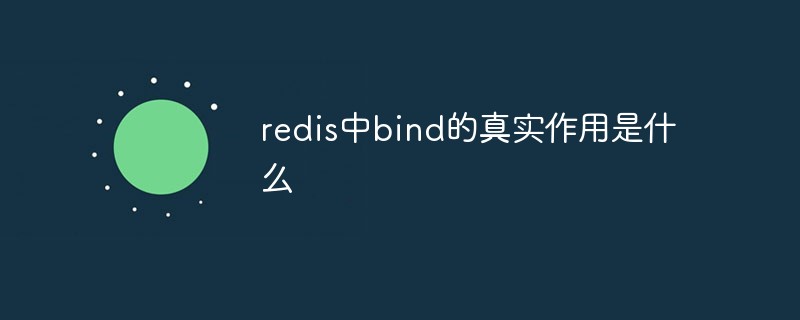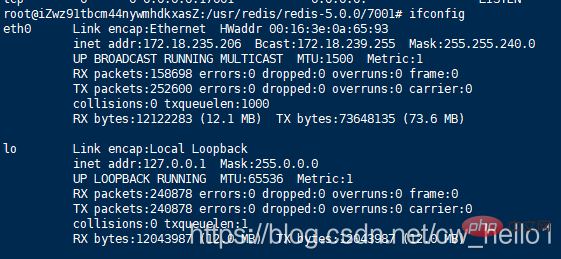What is the real role of bind in redis

I have always thought that the role of bind in the redis configuration file is to restrict the redis server to receive redis connection requests from which servers (IP addresses), only the IP addresses specified in bind Only computers can access this redis server.
Facts have proved that the above conclusion is completely wrong.
When I was building a Redis service cluster today, I discovered a misunderstanding about bind in Redis.
For example:
bind 127.0.0.1 is used to restrict that only the local computer can connect to the redis service connection
bind 0.0.0.0 is used to allow any computer to connect to redis Service connection.
Note: The above understandings are all wrong. They happen to be special cases and create an illusion about us.
If you don’t believe it, you can try: (It’s best to give it a try)
bind 10.0.0.1 (or any IP address except 127.0.0.1 and 0.0.0.0)
Then restart redis and you will find that it cannot start.

As for why it cannot start, after you know the true meaning of bind, you will understand the reason why it cannot start.
The correct understanding of bind in Redis is:
bind: is the IP address bound to the local machine, (accurately: the IP address corresponding to the local network card, each network card all have an IP address) instead of redis allowing IP addresses from other computers.
If bind is specified, it means that only Redis requests from the specified network card are allowed. If not specified, it means that Redis requests from any network card can be accepted.
For example: If there are two network cards on the redis server (local machine), each network card corresponds to an IP address, such as IP1 and IP2. (Note that IP1 and IP2 are both the IP addresses of this machine).
Our configuration file: bind IP1. Only if we access the redis server through IP1 are we allowed to connect to the Redis server. If we access the Redis server through IP2, we will not be able to connect to Redis.
Check the IP address corresponding to the local network card: use the ifconfig command.

(Learning video sharing: redis video tutorial)
It can be seen from the above that we have two network cards, that is, we only Can be used: 127.0.0.1 and 172.18.235.206 are the best bind addresses, otherwise redis will not start.
This explains why the above example (bind 10.0.0.1) cannot start because we do not have the corresponding network card IP address. This shows that bind does not specify the IP addresses from which server requests can be accepted in redis.
Instead: bind is used to specify the IP address corresponding to the local network card.
Note:
Explanation of bind 127.0.0.1: (Why only this machine can connect, but not others)
We can see from ifconfig: lo network card (Corresponding to 127.0.0.1 IP address): It is a loopback address (Local Loopback), that is, only the local computer can access this loopback address, and other computers can only access their own loopback addresses.
Then the computer from this lo network card only has this computer, so only this computer can access it, but other computers cannot.
bind 172.18.235.206, as long as the Redis request comes through this network card address (172.18.235.206), you can access redis. I use Alibaba Cloud's server. When I request the redis-cli Alibaba Cloud public IP address on another server, it will connect to the redis server.
Because requests for public network addresses all pass through the eth0 network card address (172.18.235.206), thus receiving this redis request.
When you do not use the loopback address, basically external computers can access the local Redis server.
If we want to restrict only specified hosts to connect to redis, we can only control it through the firewall, but not through the bind parameter in redis.
Use Alibaba Cloud's security group to restrict specified hosts from connecting to port 6379.
Understanding of [protected-mode] in redis:
redis itself cannot restrict [only specified hosts] from connecting to redis. As I said above, bind specification is only used Set interface addresses (interfaces).
1. If your bind is set to: bind 127.0.0.1, this is very safe, because only this host can connect to redis. Even if you do not set a password, it is safe unless someone logs in to you. on the server.
2. If your bind is set to: bind 0.0.0.0, it means that all hosts can connect to redis. (Prerequisite: Your server must open the redis port). Setting a password at this time will provide an additional layer of protection, and only those who know the password can access. That is, any host that knows the password can access your redis.
protected-mode is a security layer of redis itself. The function of this security layer is that only [this machine] can access redis, and no one else can access redis. Three conditions must be met to enable this security layer, otherwise the security layer will be closed:
(1) protected-mode yes (is on)
(2) There is no bind command. Original text: The server is not binding explicitly to a set of addresses using the "bind" directive.
(3) No password is set. Original text: No password is configured.
The redis protection mechanism will be turned on at this time. After it is turned on, only the local machine can access redis. If any of the above three conditions are not met, the protection mechanism will not be enabled.
Related recommendations: redis database tutorial
Original link: https://blog.csdn.net/cw_hello1/article/details/83444013
The above is the detailed content of What is the real role of bind in redis. For more information, please follow other related articles on the PHP Chinese website!

Hot AI Tools

Undresser.AI Undress
AI-powered app for creating realistic nude photos

AI Clothes Remover
Online AI tool for removing clothes from photos.

Undress AI Tool
Undress images for free

Clothoff.io
AI clothes remover

AI Hentai Generator
Generate AI Hentai for free.

Hot Article

Hot Tools

Notepad++7.3.1
Easy-to-use and free code editor

SublimeText3 Chinese version
Chinese version, very easy to use

Zend Studio 13.0.1
Powerful PHP integrated development environment

Dreamweaver CS6
Visual web development tools

SublimeText3 Mac version
God-level code editing software (SublimeText3)

Hot Topics
 1378
1378
 52
52
 How to build the redis cluster mode
Apr 10, 2025 pm 10:15 PM
How to build the redis cluster mode
Apr 10, 2025 pm 10:15 PM
Redis cluster mode deploys Redis instances to multiple servers through sharding, improving scalability and availability. The construction steps are as follows: Create odd Redis instances with different ports; Create 3 sentinel instances, monitor Redis instances and failover; configure sentinel configuration files, add monitoring Redis instance information and failover settings; configure Redis instance configuration files, enable cluster mode and specify the cluster information file path; create nodes.conf file, containing information of each Redis instance; start the cluster, execute the create command to create a cluster and specify the number of replicas; log in to the cluster to execute the CLUSTER INFO command to verify the cluster status; make
 How to use the redis command
Apr 10, 2025 pm 08:45 PM
How to use the redis command
Apr 10, 2025 pm 08:45 PM
Using the Redis directive requires the following steps: Open the Redis client. Enter the command (verb key value). Provides the required parameters (varies from instruction to instruction). Press Enter to execute the command. Redis returns a response indicating the result of the operation (usually OK or -ERR).
 How to clear redis data
Apr 10, 2025 pm 10:06 PM
How to clear redis data
Apr 10, 2025 pm 10:06 PM
How to clear Redis data: Use the FLUSHALL command to clear all key values. Use the FLUSHDB command to clear the key value of the currently selected database. Use SELECT to switch databases, and then use FLUSHDB to clear multiple databases. Use the DEL command to delete a specific key. Use the redis-cli tool to clear the data.
 How to read the source code of redis
Apr 10, 2025 pm 08:27 PM
How to read the source code of redis
Apr 10, 2025 pm 08:27 PM
The best way to understand Redis source code is to go step by step: get familiar with the basics of Redis. Select a specific module or function as the starting point. Start with the entry point of the module or function and view the code line by line. View the code through the function call chain. Be familiar with the underlying data structures used by Redis. Identify the algorithm used by Redis.
 How to use single threaded redis
Apr 10, 2025 pm 07:12 PM
How to use single threaded redis
Apr 10, 2025 pm 07:12 PM
Redis uses a single threaded architecture to provide high performance, simplicity, and consistency. It utilizes I/O multiplexing, event loops, non-blocking I/O, and shared memory to improve concurrency, but with limitations of concurrency limitations, single point of failure, and unsuitable for write-intensive workloads.
 How to read redis queue
Apr 10, 2025 pm 10:12 PM
How to read redis queue
Apr 10, 2025 pm 10:12 PM
To read a queue from Redis, you need to get the queue name, read the elements using the LPOP command, and process the empty queue. The specific steps are as follows: Get the queue name: name it with the prefix of "queue:" such as "queue:my-queue". Use the LPOP command: Eject the element from the head of the queue and return its value, such as LPOP queue:my-queue. Processing empty queues: If the queue is empty, LPOP returns nil, and you can check whether the queue exists before reading the element.
 How to view all keys in redis
Apr 10, 2025 pm 07:15 PM
How to view all keys in redis
Apr 10, 2025 pm 07:15 PM
To view all keys in Redis, there are three ways: use the KEYS command to return all keys that match the specified pattern; use the SCAN command to iterate over the keys and return a set of keys; use the INFO command to get the total number of keys.
 How to implement the underlying redis
Apr 10, 2025 pm 07:21 PM
How to implement the underlying redis
Apr 10, 2025 pm 07:21 PM
Redis uses hash tables to store data and supports data structures such as strings, lists, hash tables, collections and ordered collections. Redis persists data through snapshots (RDB) and append write-only (AOF) mechanisms. Redis uses master-slave replication to improve data availability. Redis uses a single-threaded event loop to handle connections and commands to ensure data atomicity and consistency. Redis sets the expiration time for the key and uses the lazy delete mechanism to delete the expiration key.




